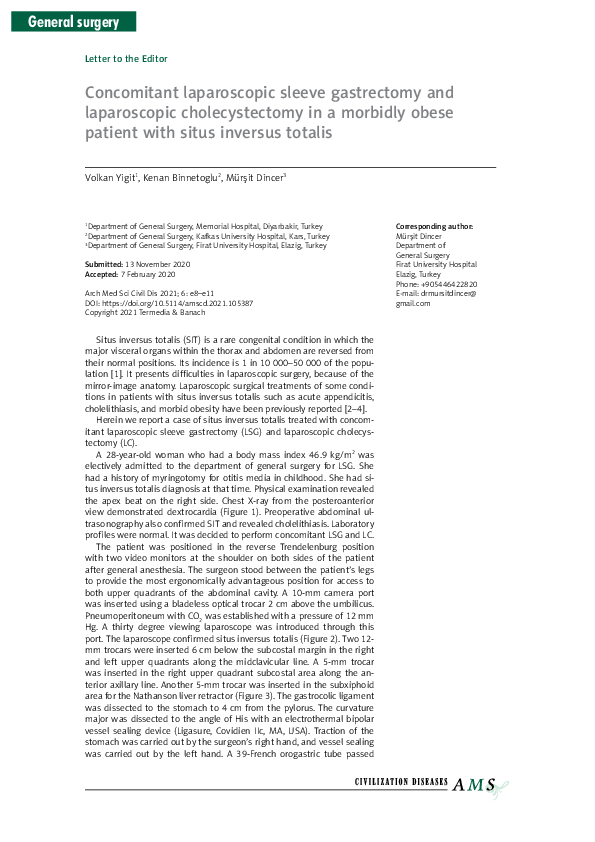Academia.edu no longer supports Internet Explorer.
To browse Academia.edu and the wider internet faster and more securely, please take a few seconds to upgrade your browser.
Concomitant laparoscopic sleeve gastrectomy and laparoscopic cholecystectomy in a morbidly obese patient with situs inversus totalis
Concomitant laparoscopic sleeve gastrectomy and laparoscopic cholecystectomy in a morbidly obese patient with situs inversus totalis
2021, Archives of Medical Sciences
Related Papers
Indian Journal of Anaesthesia
The challenging aspects and successful anaesthetic management in a case of situs inversus totalis2012 •
2021 •
Situs inversus totalis represents a rare autosomal recessive morphological anomaly of the internal viscera, equally affecting both genders. The genetic defect occurs in the 2nd week of embryonic life, when a 270-degree clockwise rotation of the primitive digestive tube occurs. The incidence of calculosis of gallbladder in patients with situs inversus is the same as in the general population. A 61-year-old female patient with a history of four episodes of colicky, left hypochondrium and epigastric pain, without fever and jaundice, was admitted for elective laparoscopic cholecystectomy. CT of abdomen confirmed situs inversus totalis that was previously known to the patient. The patient was positioned in supine position and a mirror image configuration of the operating room was obtained, with surgeon and scrub nurse on the right side and assistant on the left side of the patient. Four trocars were introduced mirroring the standard position of the 5 mm trocars. During the dissection, se...
Sultan Qaboos University Medical Journal
Retrograde (fundus first) Laparoscopic Cholecystectomy in Situs Inversus Totalis2012 •
2021 •
Situs inversus totalis (SIT) has an incidence in the general population of 1/10,000, with a female-male ratio of 1:1.5 without racial predilection. Clinically, SIT by itself tends to be asymptomatic; however, when it is associated with other conditions such as cholecystitis or appendicitis, the diagnosis may represent a challenge due to the reversed anatomical location of symptoms. This article presents a case of a 46-year-old female who arrived at the emergency department due to one week of non-bilious vomiting and colicky abdominal pain located in the left hypochondrium; therefore, abdominal ultrasonography was performed, showing transposition of abdominal organs associated with cholelithiasis plus acute cholecystitis. As a result, the patient was scheduled for laparoscopic cholecystectomy, resulting in an appropriate post-surgical evolution, for which discharge was given with a general surgery control appointment. Laparoscopic cholecystectomy in patients with SIT represents a challenge due to the technical complexity derived from the transposition of the abdominal organs; therefore, the surgeon is forced to perform the procedure by placing three trocars with a specular approach plus the umbilical trocar.
2020 •
Situs inversus represents abnormal anatomy of thoracic and abdominal organs. It is referred to as “mirror-imaging” of major organs of the body. This is a case report of a patient with situs inversus having cholelithiasis who underwent successful laparoscopic cholecystectomy. Management of such patients requires thorough investigations and meticulous surgical technique.
2015 •
International Archives of Medicine
Laparoscopic Approach In Patient With Situs Inversus Totalis And Colelithiasis: A Case Report2017 •
Title: Laparoscopic Approach in Patient with Situs Inversus Totalis and Colelithiasis: a Case Report. Background: Situs Inversus Totalis is a rare clinical condition that gives a mirror aspect to the position of the organs. It is a congenital condition and though it does not affect normal health or longevity, it may be a challenge in cases requiring surgical intervention. Case: The authors report a case of cholelithiasis in a patient with previous diagnosis of Situs Inversus Totalis. The patient presented abdominal pain, related to eating and associated with nausea and vomiting. After the image exams, it was performed the surgical procedure, without intercurrences. Conclusion:Situs Inversus Totalis is a challenge for surgical approach because of the mirrored configuration of the organs, which can lead to misdiagnosis. Using image exams anda complete evaluation of the patient helps the correct management in caso of surgical procedures, and consequently influence in the prognosis.
Archives of Clinical and Experimental Surgery (ACES)
Laparoscopic cholecystectomy in situs inversus totalis: A review article2015 •
International Journal of Surgery Case Reports
A case report of laparoscopic cholecystectomy in situs inversus totalis: Technique and anatomical variation2016 •
RELATED PAPERS
2020 •
2024 •
2017 10th International Conference on Electrical and Electronics Engineering (ELECO)
Steps for industrial plant electrical system design2017 •
A. Canepa (a cura di), Il mercato dei Non-Fungible Tokens tra Arte, Moda e Gamification, Milano University Press, 2023.
NFT e nuove opportunità per gli artisti (umani e non): l'esempio di Botto2023 •
International Journal of Social Welfare
Families of adult people with disability: Their experience in the use of services run by social cooperatives in Italy2017 •
Apunts. Educación Física y Deportes
La construcción social y cultural del liderazgo.2005 •
2005 •
2013 •
Advanced Functional Materials
Scaling Behavior of Resistive Switching in Epitaxial Bismuth Ferrite Heterostructures2014 •
South African Journal of Botany
Comparative chemical profiling and antimicrobial activity of two interchangeably used ‘Imphepho’ species (Helichrysum odoratissimum and Helichrysum petiolare)2021 •
Indian Journal of Fisheries
Estimating shark body sizes from fins as the future monitoring strategy for shark fin trade in IndonesiaZenodo (CERN European Organization for Nuclear Research)
Reduction of Overheads with Dynamic Caching in Fixed AODV based MANETs2008 •

 Kenan Binnetoğlu
Kenan Binnetoğlu